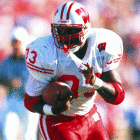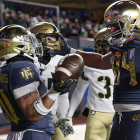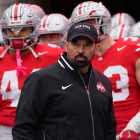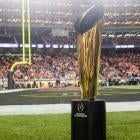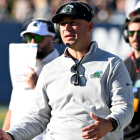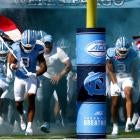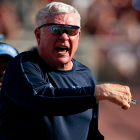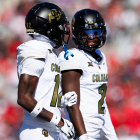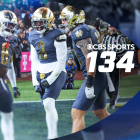Ron Dayne still considers himself the NCAAâs all-time rushing leader. Itâs just that -- officially and forever -- he isnât.
In fact, Wisconsinâs former All-American and Heisman Trophy winner (1999) recently updated his Facebook profile to read âNCAA All-Time Career Rushing Leader with bowl games.â
That last phrase ... with bowl games ... reflects a mini-controversy.
Itâs not like Dayne didnât run for the 728 yards in four career bowl games. Itâs that the NCAA didnât count those yards. Only since 2002 -- three years after Dayne left Wisconsin -- has the NCAA counted postseason yards. Dayne, it turns out, played at the wrong statistical time (1996-99).
Much was made -- by the NCAA, by San Diego State and by Pumphrey -- when the Aztecs tailback rushed for 115 yards in Decemberâs Las Vegas Bowl to âpassâ Dayne with 6,402 career yards.
Only he hadnât, not to Dayne who has 7,125 career yards counting his bowl games.
âItâs their mistake,â Dayne said of the NCAA. âI canât really be too upset, [but] I still have the rushing yards [record]. How can he be the NCAA rushing leader?â
The Pumphrey-Dayne statistical dust-up is the most significant since the NCAA decided to change the way it compiles football stats 15 years ago.
Players like Dayne, whose careers ended before the statistical switch was flipped in 2002, are left to argue their case in a vacuum.
But officially, Pumphrey is now the NCAA career leader with 6,405 yards thanks to 428 yards gained in four career bowl games. Officially, Dayne is second 6,397 yards with no bowl games counted.
Fair?
âThe NCAA said it,â Dayne told CBS Sports. âI donât want to fight and jump around.â
Dayne does alternately protest and accept how his numbers have been redefined.
âHeâs really not the NCAA leading rusher,â Dayne said of Pumphrey. âI had [more than] 7,000 total rushing yards. ... I think he should say something about it, too.â
Letâs just say Mountain West commissioner Craig Thompson disagrees with that statement.
âThere will always be a point in time when standards change,â he told CBS Sports. âItâs not Donnel Pumphreyâs place to determine such. He didnât make the ruling, nor should he apologize for rushing for 6,402 yards over his career and be recognized however and by whomever determines his ranking.â
Here a look at the two different top-five rushing lists.
| Top five counting bowls prior to 2002 | Yards | Top five as recognized by NCAA | Yards | ||
| 1 | Ron Dayne, Wisconsin | 7,125 | Donnell Pumphrey, San Diego State | 6,502 | |
| 2 | Ricky Williams, Texas | 6,592 | Ron Dayne, Wisconsin | 6,397 | |
| 3 | Tony Dorsett, Pittsburgh | 6,526 | Ricky Williams, Texas | 6,279 | |
| 4 | Donnell Pumphrey, San Diego State | 6,502 | Tony Dorsett, Pittsburgh | 6,082 | |
| 5 | Charles White, USC | 6,245 | DâAngelo Williams, Memphis | 6,026 |
For Dayne, and his Wisconsin supporters, it is a career honor that exists perhaps only in their hearts and minds.
Dayne passive-aggressively trolled Pumphreyâs moment in December with a congratulatory tweet ending with #7,215.
Congratulations young man #GOAT #7125
— Ron Dayne (@Ron33Dayne) December 17, 2016
âI think about it when Iâm with my buddies and somebody says something, âThis is Ron Dayne, the NCAA leading rusher. Well, uh ...â
âI guess I can still say it, but I donât anymore,â Dayne said.
Four years after he retired, widely respected former NCAA statistician Jim âJungleâ Wright still hears the outcry.
âWeâll go ahead and change that because we know what Ron Dayne did in that bowl game,â Wright said rhetorically. âThatâs great until you hear from the grandfather of some kid, âMy grandson caught 10 passes in the Cotton Bowl in 1968.â
âThere would be no end to it.â
Wright makes an important point. But as time passes, the argument over career records falling with the aid of postseason ammunition should only increase.
More years, more yards, more postseason numbers to pile up on record holders who had no such advantage.
Consider that Oklahoma Stateâs Mason Rudolph is the countryâs third-leading returning passer for 2017 (8,714 yards). Almost 10 percent of those yards have come in bowl games (729).
To move into the top five among Big 12 passers, Rudolph would have to throw for 3,711 yards. Except that No. 5 passer -- Texas Techâs Kliff Kingsbury -- had 616 passing yards from bowls that didnât count in 2000 and 2001.
âWhile it is true that Ron Dayneâs record could easily be recalculated, think about once you open up that door,â Wright said. âThink about hundreds and thousands of records there are in football.â
A lot of folks have. They want the NCAA to retroactively count all bowl records.
Wright and those who replaced him contend a wholesale rewriting of the NCAA records book couldnât possibly be accurate.
Wright said as recently as the 1970s there werenât complete records of bowl box scores. A complete updating of the records would require scrutiny of 400-500 records at each of the NCAAâs four divisions -- FBS, FCS, Division II and Division III.
But in this age of enhanced metrics, there has to be someone out there willing to try. Heck, assign a summer intern at each school to update that schoolâs bowl stats.
Judge the lack of statistical symmetry for yourself. The NCAA does not count the approximately 960 bowl games from 1937-2001. But is does count the approximately 500 bowl games since 2002.
âFrom a personal standpoint, I didnât look at it from the Ron Dayne standpoint,â said Wright, who retired in 2013. âYou look at it from the view of some schoolâs hall of champions.
âThey say, âOur guy was punting champion in 1972.â Years later youâre going to say, âWe threw in some guyâs Rose Bowl numbers and youâre no longer the leader?ââ
It has sort of happened already. The Big Eight morphed into the Big 12 more than 20 years ago. Except for those who have a physical copy of the last Big Eight records book, those records no longer exist.
The Big 12 started over with a new record book in 1996.
There is a bit of a circular argument at work. Those NCAA statisticians have contended many times they donât want to âre-write historyâ by retroactively counting those bowl stats.
But isnât that exactly what is happening by not counting those numbers from 1937 (first year of NCAA stats) to 2001?
Wright said for years the argument against counting bowl stats was Archie Griffin. It wasnât fair that Ohio Stateâs double Heisman Trophy winner could have stats from four bowl games in his career.
There were only six bowl games in 1937. At the end of Griffinâs career in 1975, that number had increased only to 11.
There are now 41 postseason games counting the College Football Playoff. Clemson quarterback Deshaun Watson has played a combined four CFP games the last two seasons -- equivalent to one-third of a regular season.
Almost 15 percent of his passing yards and 12 percent of his touchdowns in those years came in the CFP.
Consider this recent rewritten history:
- Alabamaâs Derrick Henry became the SECâs first 2,000-yard rusher only with the help of 223 yards gained in the Tideâs two College Football Playoff games in 2015.
- Wisconsinâs Melvin Gordon nearly broke Barry Sandersâ single-season rushing record (2,628 yards, 1988) in 2014. One problem: Gordon needed his 251 yards gained in the Outback Bowl that season to come within 41 yards of Sandersâ record. Sanders didnât have that advantage. Applying his 222 rushing yards in the 1988 Holiday Bowl, that would have pushed his rushing record to 2,850 yards.
- The career of NC State quarterback Philip Rivers -- the ACC career passing leader -- straddles the line. A pair of bowl games in 2000 and 2001, in which he passed for a combined 499 yards ,do not count. Two bowl games in 2002 and 2003 totaling 703 passing yards did count.
- For years, the Pac-10 and NCAA had different statistical philosophies. The Pac-10 counted bowl records while the NCAA did not.
- Colorado sports information director Dave Plati has never counted bowl games. His rationale, â ... to have instances where some players have bowls count and some donât ... never made sense to me.â
The NCAA has addressed some of the disparity by tracking average yards per game. That accounts for the difference between a player who might participate in 15 games and another who plays only 12.
Example: Pumphrey led the nation with 2,133 rushing yards last season. Texasâ D'Onta Foreman led the country with 184.4 yards per game.
Both can call themselves rushing champions.
The statistical kerfuffle points up a crisis that isnât going away. But how to break the bad news to the likes of all-time greats like Dayne who have to be told their records donât count anymore?
âHopefully my sons and some other kids will get close to it and re-break it,â the Great Dayne said, âGet to a school that wants to run the ball like my coach ran me.â







